Late Gothic Vertigo
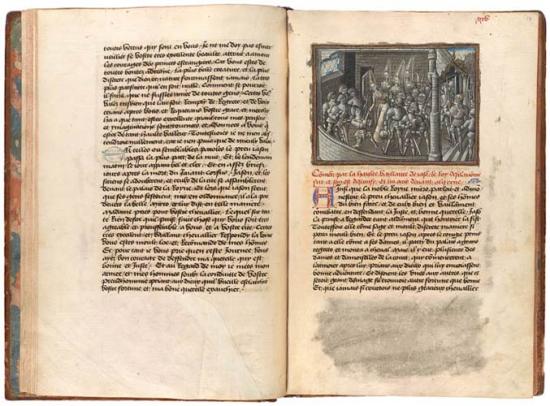
History of Jason, in French
Illuminated in the style of the Master of the Champion des Dames
Purchased by Pierpont Morgan, 1902
Women's Headgear Reaches Its Climax
The look for women in the 1460s and '70s was defined by the turret. In French this headgear was called a haut bonnet (high bonnet) or mitre (after the bishop's ceremonial miter). An attenuated cone, the turret was normally worn with wafting transparent veils. As seen in the miniature here, it was sometimes the custom for these veils to fall below the eyes. The turret was affixed to the head via the templet, a cloth or metal base. At the bottom of each turret shown here is a small hoop: this is the visible part of the templet to which the turret is anchored.
Late Gothic Vertigo
In the 1460s and '70s fashions reached their Gothic climax. The look for both men and women was tall, long, and lean. Thin was in.
The look for men was dominated by the gown, worn either very short (to the crotch—or barely so) or very long (to the ground). Both versions, accented by a thin belt around a narrow waist, featured high padded shoulders and pleats that flared down over the buttocks and up over the back and chest. These features, developed during the previous decades, brought to a culmination the flatteringly masculine V-shaped silhouette. Pouleines, which accented the lean look, were revived. The chaperon, in fashion for over a hundred years, finally went out of style as new hats–especially a tall, loaf-shaped version—arrived.
Women's gowns continued with their wide V necks, high wasp waist, and long trains. For headgear, temples went out of fashion and were replaced by the turret. This cone-shaped coif, from the tip of which cascaded transparent veils, is perhaps the stereotypical ladies' hat from the late Middle Ages.
Geneviève: The Period's Poster Girl
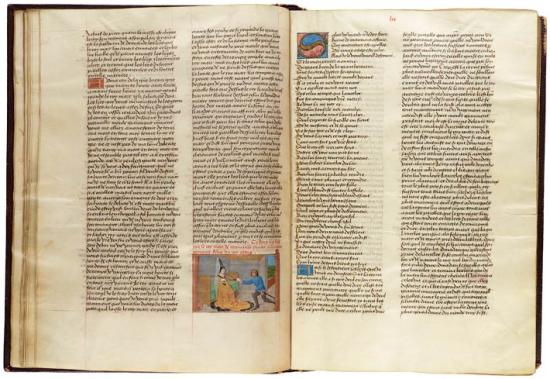
Romance of Tristan, in French
Illuminated by the Master of the Vienna Mamerot
Purchased by Pierpont Morgan, 1903
Geneviève, receiving King Mark's letter, exemplifies this period's look. Her turret, from which cascades a transparent veil, terminates upon a frontlet, a wide band of cloth that frames her face. (The frontlet would play an important role over the next decades.) Her wide, V-necked gown has a high, narrow waist and tight sleeves with funnel cuffs. Black, a popular color at this time, accents her turret and frontlet, collar, cuffs, and wide hem. The distinctive feature of men's clothing here is the revival of pouleines.
Late Gothic Vertigo
In the 1460s and '70s fashions reached their Gothic climax. The look for both men and women was tall, long, and lean. Thin was in.
The look for men was dominated by the gown, worn either very short (to the crotch—or barely so) or very long (to the ground). Both versions, accented by a thin belt around a narrow waist, featured high padded shoulders and pleats that flared down over the buttocks and up over the back and chest. These features, developed during the previous decades, brought to a culmination the flatteringly masculine V-shaped silhouette. Pouleines, which accented the lean look, were revived. The chaperon, in fashion for over a hundred years, finally went out of style as new hats–especially a tall, loaf-shaped version—arrived.
Women's gowns continued with their wide V necks, high wasp waist, and long trains. For headgear, temples went out of fashion and were replaced by the turret. This cone-shaped coif, from the tip of which cascaded transparent veils, is perhaps the stereotypical ladies' hat from the late Middle Ages.
Catfight at the Crossroads
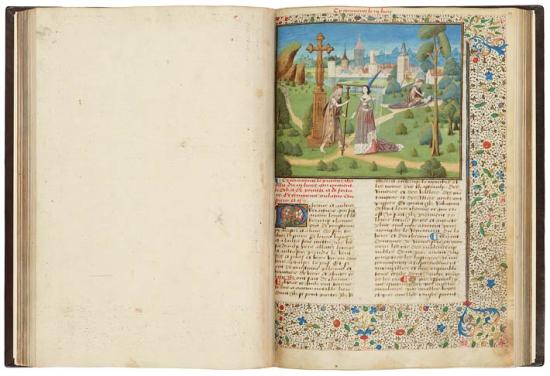
Of Noble Men and Women, in French
Purchased by Pierpont Morgan, 1908
Boccaccio's works were popular in France, appearing in translation in the fourteenth and fifteenth centuries. In the miniature shown here, personifications of Fortune and Poverty meet at a crossroads. Poverty, dressed like a poor pilgrim in ragged clothes, has a walking stick and a hat to which are affixed badges of the shrines she has visited. Fortune is dressed to the nines. Her turret, anchored to her face with a black frontlet, is vertiginously tall. Her narrow-waisted, V-necked gown features ermine at the collar, cuffs, and wide hem. As seen in the right background, the meeting ends poorly.
Late Gothic Vertigo
In the 1460s and '70s fashions reached their Gothic climax. The look for both men and women was tall, long, and lean. Thin was in.
The look for men was dominated by the gown, worn either very short (to the crotch—or barely so) or very long (to the ground). Both versions, accented by a thin belt around a narrow waist, featured high padded shoulders and pleats that flared down over the buttocks and up over the back and chest. These features, developed during the previous decades, brought to a culmination the flatteringly masculine V-shaped silhouette. Pouleines, which accented the lean look, were revived. The chaperon, in fashion for over a hundred years, finally went out of style as new hats–especially a tall, loaf-shaped version—arrived.
Women's gowns continued with their wide V necks, high wasp waist, and long trains. For headgear, temples went out of fashion and were replaced by the turret. This cone-shaped coif, from the tip of which cascaded transparent veils, is perhaps the stereotypical ladies' hat from the late Middle Ages.
Personification of Pride
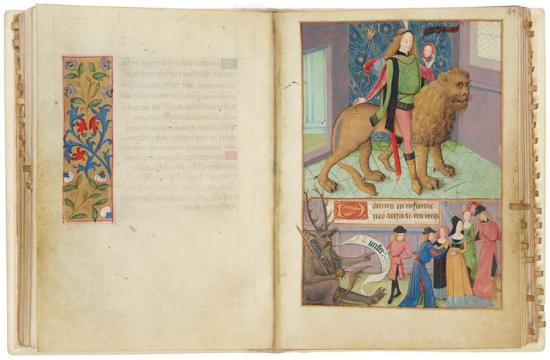
Book of Hours, in Latin
Illuminated by Robinet Testard
Purchased through the Fellows Fund, 1979
Each of this prayer book's Penitential Psalms is illustrated with a personification of a sin to be avoided. The series begins with the first of all sins, Pride, who rides a lion while admiring himself in a mirror. He wears an embroidered green gown with slit sleeves and, under that, a red velvet doublet. His accessories include a headband (with feather), necklace, and studded belt. Thrown over his right shoulder is the black cornet attached to a small gray hat that falls down his back. In the bottom border, Lucifer encourages people to engage in arrogant and pompous behavior.
Late Gothic Vertigo
In the 1460s and '70s fashions reached their Gothic climax. The look for both men and women was tall, long, and lean. Thin was in.
The look for men was dominated by the gown, worn either very short (to the crotch—or barely so) or very long (to the ground). Both versions, accented by a thin belt around a narrow waist, featured high padded shoulders and pleats that flared down over the buttocks and up over the back and chest. These features, developed during the previous decades, brought to a culmination the flatteringly masculine V-shaped silhouette. Pouleines, which accented the lean look, were revived. The chaperon, in fashion for over a hundred years, finally went out of style as new hats–especially a tall, loaf-shaped version—arrived.
Women's gowns continued with their wide V necks, high wasp waist, and long trains. For headgear, temples went out of fashion and were replaced by the turret. This cone-shaped coif, from the tip of which cascaded transparent veils, is perhaps the stereotypical ladies' hat from the late Middle Ages.
A Fop Goes Hawking (Part 1)
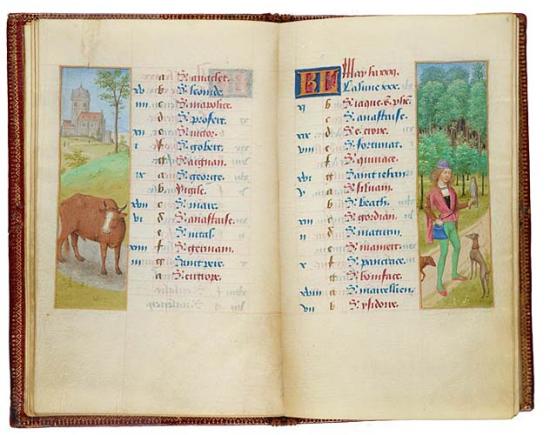
Book of Hours, in Latin and French
Illuminated by Simon Marmion
Purchased by Pierpont Morgan, 1900
Calendars in prayer books are often excellent sources for depictions of contemporaneous clothing. The month of May, shown here on the right, is illustrated by the leisurely occupation of hawking. The youth wears a gown with slit sleeves and a skirt so short it no longer covers his crotch. The tan sleeves and black front of his doublet and, at his neck, the top of his linen shirt are all visible. The lilac of his hat and pink of his shoes were favorite colors of the illuminator, Simon Marmion. (On the left is Taurus, the zodiacal sign for the month of April.)
Late Gothic Vertigo
In the 1460s and '70s fashions reached their Gothic climax. The look for both men and women was tall, long, and lean. Thin was in.
The look for men was dominated by the gown, worn either very short (to the crotch—or barely so) or very long (to the ground). Both versions, accented by a thin belt around a narrow waist, featured high padded shoulders and pleats that flared down over the buttocks and up over the back and chest. These features, developed during the previous decades, brought to a culmination the flatteringly masculine V-shaped silhouette. Pouleines, which accented the lean look, were revived. The chaperon, in fashion for over a hundred years, finally went out of style as new hats–especially a tall, loaf-shaped version—arrived.
Women's gowns continued with their wide V necks, high wasp waist, and long trains. For headgear, temples went out of fashion and were replaced by the turret. This cone-shaped coif, from the tip of which cascaded transparent veils, is perhaps the stereotypical ladies' hat from the late Middle Ages.
Pinnacle of the V-Shaped Silhouette for Men
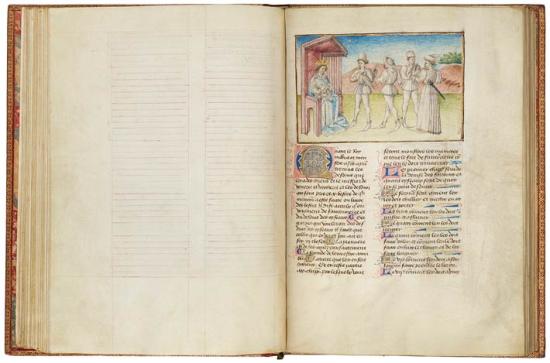
Livre du roy Modus et de la royne Racio
Illuminated by the Master of the Vienna Roman de la rose (Jean Hortart?)
Purchased, 1947
Ferrières's treatise on hunting is open to the chapter on falconry, illustrated with an enthroned King Modus instructing youths in the art of hunting with birds. The pen-and-wash medium carefully delineates the tailoring of their garments. Three young men wear the short gown with pleating that flares flatteringly both below and above the narrow waist. The slit sleeves are highly padded at the shoulders. While the youths sport the revived pouleines, two also wear loaf-shaped caps, typical of the 1460s. The hunter at right, who prefers the long gown, wears a "burlet-chaperon," headgear in which the fat burlet is permanently rolled.
Late Gothic Vertigo
In the 1460s and '70s fashions reached their Gothic climax. The look for both men and women was tall, long, and lean. Thin was in.
The look for men was dominated by the gown, worn either very short (to the crotch—or barely so) or very long (to the ground). Both versions, accented by a thin belt around a narrow waist, featured high padded shoulders and pleats that flared down over the buttocks and up over the back and chest. These features, developed during the previous decades, brought to a culmination the flatteringly masculine V-shaped silhouette. Pouleines, which accented the lean look, were revived. The chaperon, in fashion for over a hundred years, finally went out of style as new hats–especially a tall, loaf-shaped version—arrived.
Women's gowns continued with their wide V necks, high wasp waist, and long trains. For headgear, temples went out of fashion and were replaced by the turret. This cone-shaped coif, from the tip of which cascaded transparent veils, is perhaps the stereotypical ladies' hat from the late Middle Ages.